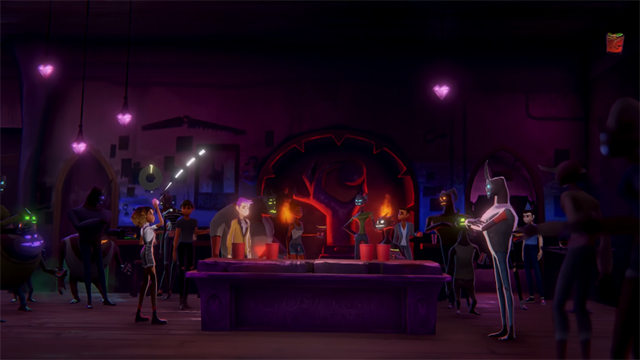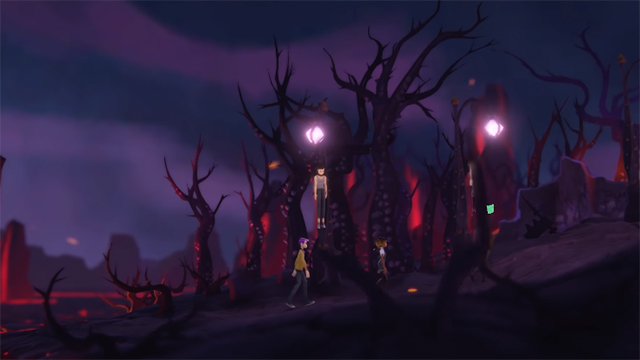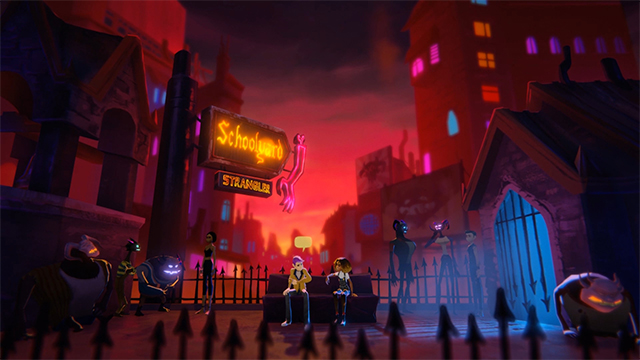While we liked what we played, Afterparty is an odd game that deserves some explanation. Luckily, we got exactly that. Studio Director Sean Krankel and Game Director Adam Hines (who are also cousins) made the time to chat with us about the hellish drinking game. We chatted with us about the game’s odd premise, how it pushes dialogue systems forward, and Satan because every interview should talk about the dark lord himself.
GameRevolution: Night School started with some Telltale staff. Oxenfree was sort of in that same genre but pushed the dialogue system forward. How has Afterparty advanced that system too?
Adam Hines: With Oxenfree, you could always pick the top three choices that Alex would want to say and those would make sense for her character. For this one, we wanted to give you the opportunity to roleplay in that you could kind of emulate the feeling of going out on a bar crawl. So if you were in a pissed off mood, you might drink a certain way. Or if you were in a flirty mode, you’d drink a certain way in the bar. Of course in hell, we can boost that way more. So there are drinks that will make you talk like a pirate. There are drinks that will make you throw up your conscience and you have to chase it around.
Basically whenever you walk into a bar, there’s about four to six drink types that you can take and whichever one you pick will change your dialogue choices to conform to that personality that you want to be. It’s to help the replayability of the game and you can beat the game only drinking in an angry mode or in certain ways and then you can play the whole thing in a different style too.
GR: So this game branches out a lot?
AH: Exactly. So our big goal with it is that every goal you have or obstacle that you have to overcome, there’s two ways to do that. That feeds into the drinking or minigames that you can do. And that’s another big thing that we wanted to change from Oxenfree. In Oxenfree, it was a laidback easy game where you could make choices through the story. In this one, we wanted some aspect that you could get good at.
So we have drink offs, which is a parody of the Indiana Jones scene, where you’re taking shots for shots against characters. Or you’re playing beer pong.

GR: Where did the idea for this game come from?
Sean Krankel: Originally, we wanted to do something that was more lighthearted than Oxenfree because it was pretty dark and serious. So making a comedy adventure seems like something that not a lot people are doing so that would be a fun thing to try. We wanted a more limited environment initially. We thought maybe we should do a bar and that will be it.
You’d be in a single location and be a bartender and a lot of characters would show up and that was a big change for us from Oxenfree where you are with a small cast moving through an environment and everyone has the same goal in that game. And then we were like “Couldn’t we do a game where a lot of people have differing goals but are in a smaller environment?”
Well, we very quickly thought being a bartender would be lame. We’d rather be drinking! Let’s turn it into a pub crawl We still didn’t have the hell idea. It was more like a wild night out. And then finally we thought it should be against something. Who would be a good antagonist? On a lark, we were wandering through the cemetery by our office and thought it would be pretty funny if you had to outdrink Satan. And then we were like “Uh that’s dumb. Let’s not do that.”
And then a week went by and we we thought that was the best idea of all. Like who would be the gnarliest person to party with? Satan, of course. From there, the hell part merging with the rest of that design that we had, it was one of those creative “aha!” moments where we could do whatever we want. We can invent our own version of hell. It’s familiar enough to people because people have a preconceived notion about hell but but we can tweak all of it.
GR: What liberties did you take with your version of Hell?
SK: In general, and this is going to sound stupid, but it’s like Pixar takes something familiar like toys, bugs, or cars and make their own version of that universe. So when we landed on hell, we thought that there’s enough that everyone can bring to it and understand. And now we can go “let’s change the art direction completely” or “let’s invent a set of characters that shouldn’t belong there” or “let’s use the River Styx” and all these things that people are familiar with and tie it together. That was exciting because there were always things to fall back on and get inspired by but room for a lot of new ideas.
AH: In this game, we assumed that every religion is right. So we put every rule on top of each other and just had fun with that like what demons correspond to what rules or what humans are in hell for what purposes. But we definitely wanted a weird mish mash of modern architecture and old ideas and bunch of weirdness.

GR: The Afterparty’s two protagonists just graduated college and Oxenfree were just teenagers. Both are pretty well written. So how do you authentically write for young people without seeming out of touch or like you’re trying too hard?
AH: My idea of what we try to do as a studio is to write the characters just as characters. We don’t look at it like “this is an 80-year-old man so he should talk like this” or “this is a 16-year-old girl so she should talk like this.” It’s just writing and trying to very true to what they would really want to say and trying to be as specific with how they would want to express things. We really just try to avoid cliches in how they would actually talk.
We’re fine with being kind of stereotypical in the overall arches or plot points. At least for us, we think people take comfort and joy in seeing how a kind of typical story would play out with unique characters in it.
GR: Afterparty had some solid jokes in it. This is the most unfunny way to ask this but how do you write a joke and make sure that it’s funny?
AH: For me, in general, if we think it’s funny, then we know somebody out there will think it is funny just because we’re not unique and no one is unique. So it’s a lot of tweaking the timing because comedy is so much of making sure the joke hits on this beat like there isn’t too long of a pause or making sure it doesn’t step on this other line. A lot of it is going in and tweaking exactly when the overlapping dialogue happens and hitting things on the right beats.
And there are so many jokes. So if you don’t like that one, just wait five seconds and another one is coming.
GR: Oxenfree was successful but you probably looked at it after and wanted to fix things. What did you want to fix that you implemented in this game?
SK: There weren’t any broad sweeping things that weren’t proud of in that game. It was more of looking at what we could have done more with or stuff we wanted to do that fell by the side. For example, we wanted to do more modular stories.
Oxenfree’s story is quite linear. In this game, you can play the game in a variety of orders and you can miss a lot of content. Like if there are two parties, you’re gonna miss the other party. Ideally, everyone’s playthrough is going to sound different like in what characters you meet or what you said. We wanted it to feel like a real night out where the best nights out partying with your friends are sort of like a blur of bouncing around. The game is intended, design-wise, to feel like that way. Whereas Oxenfree was very focused on getting the hell out of there, this game should feel like you’re brought into this crazy pub crawl.
The structure was one way. The other ways letting the player find more ways to influence the story. The drinks are a meaningful way to change the dialogue. It’s not like the different drinks are a right or wrong solution. It’s more like what flavor you want to have. Giving players more ways to customize the personality of the character felt like a cool next step. And also crazier art.
AH: We also wanted more characters to talk to. In Oxenfree, it’s a great, purposely limited cast. In this one, there is a world of demons and humans.

GR: Afterparty reminded me a lot of the film, The World’s End. Was that on purpose?
AH: We definitely took a lot of inspiration from that movie in particular but, in general, Edgar Wright’s tone. He has the great vibe of it’s clearly a comedy and clearly a hyperkinetic kind of pitch to the hilt world, but he also has a lot of heart and you really care about those characters at the same time.
GR: Given the premise, there’s going to be a lot of music in this game. How do you make sure that it doesn’t loop too often and get annoying?
SK: The way the music is getting treated in this game is totally different than Oxenfree. In Oxenfree, it was just a score that would play along with whatever the narrative beats were. Whereas this, we kind of want this to feel like how it is when you go out. So when you’re outside, you’ll hear the throbbing music from inside. And when you go inside, the soundscape changes and has that boom that feels like you’re in a physical space.
This is more diegetic music that is really part of the environment you’re in. But we also still want it to react. For example, when you go up and order a drink, we wanted to drop out the percussion to make it feel different. Or you’re playing beer pong and things escalate so we’re trying to have our cake and eat it too where it is acting like a score that is reacting to you but it is also part of the diegetic music.
There will be different DJs in different bars so, depending on the size of the bar, we’ll have multiple songs that, even though it’s looping, will mix into something else. And the player can sometimes go up to a jukebox and switch the song. So there’s a whole wealth of music. And it is an interesting mix because sometimes you’re trying to match the tone of moment but also have it feel like it could just be a song on the radio. It’s a difficult challenge and a fun one.
Andy Rohrmann, who goes by scntfc, did all the music for Oxenfree and is doing the music for this too. He’s so talented that it hurts. [laughs] We told that we wanted it to sound like Tobacco and Run the Jewels. And he said he understood and came back with this.







